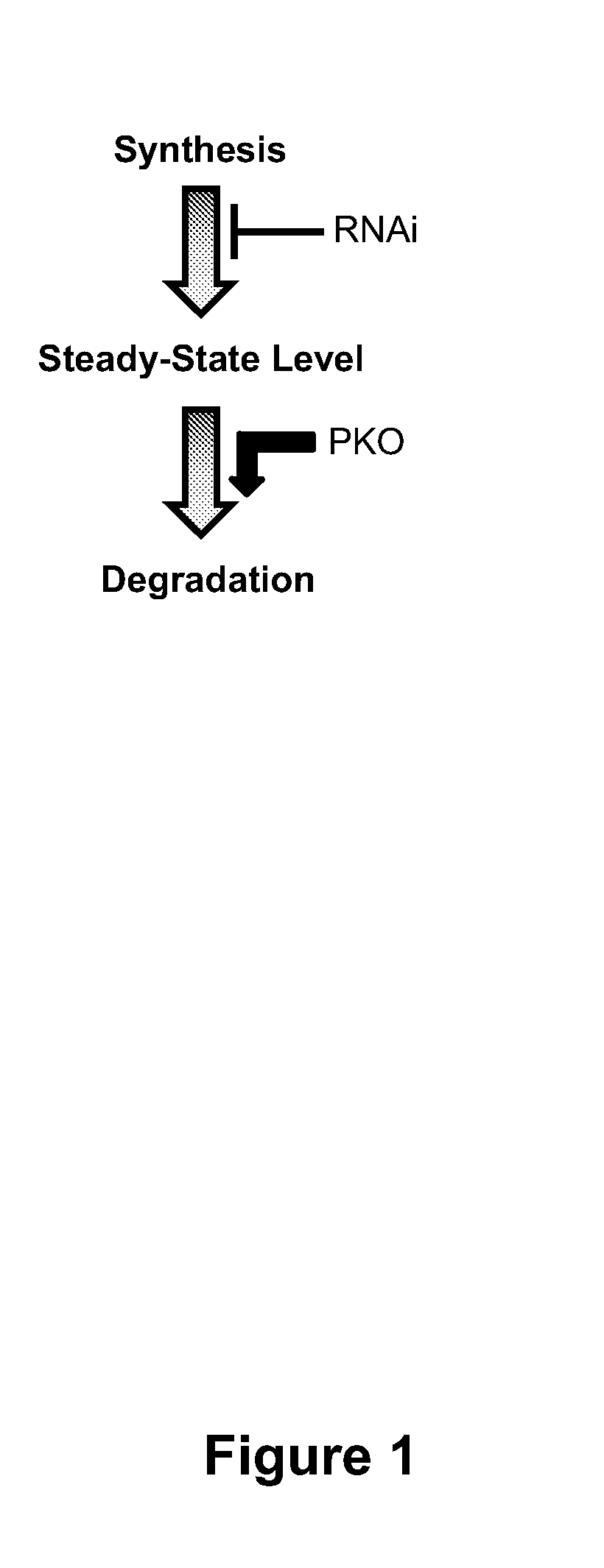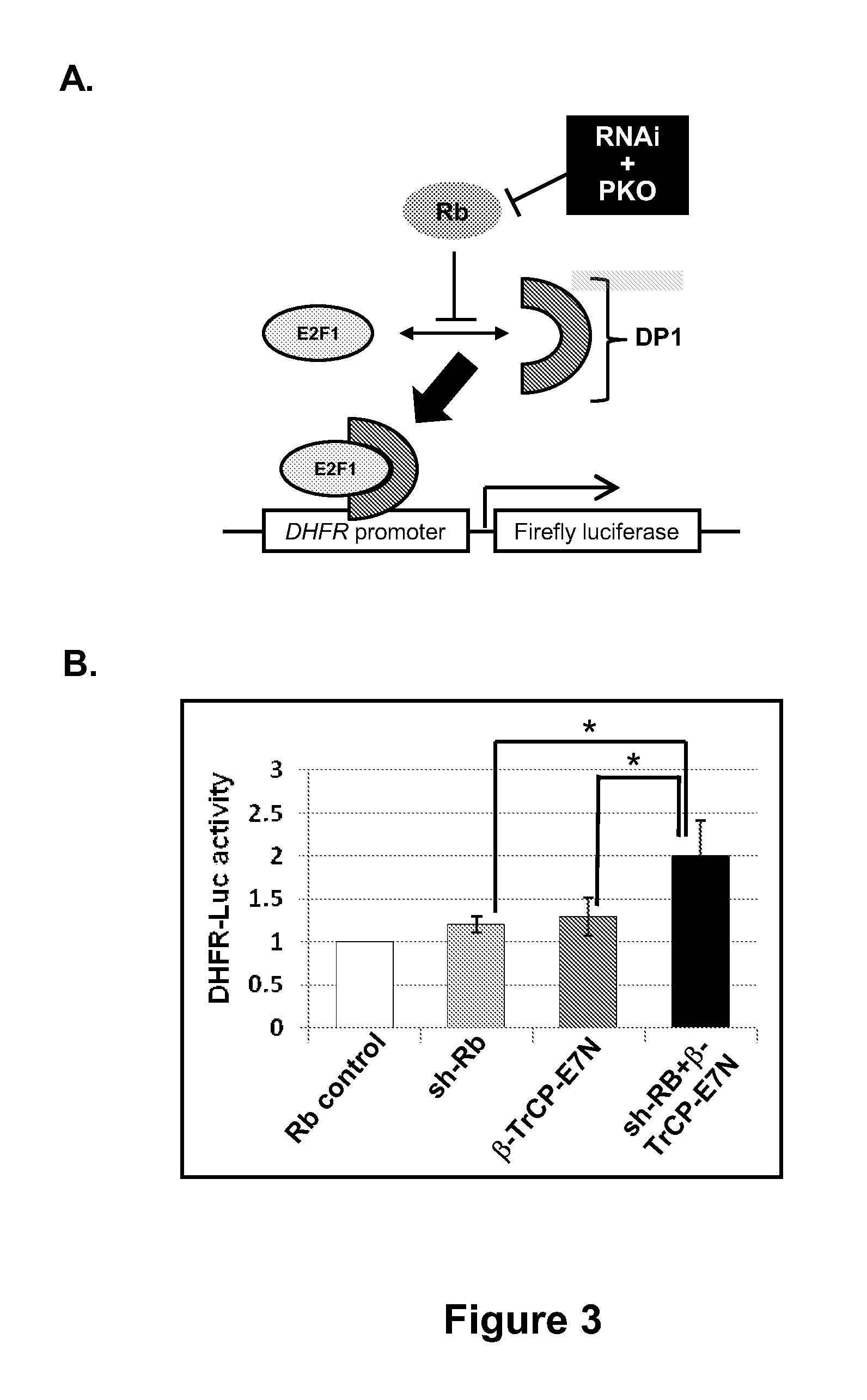Methods for Reducing Protein Levels in a Cell
a technology of protein levels and cell, applied in the field of cell protein levels reduction, can solve the problems of insufficient ablation of protein expression, inability to achieve immediate depletion of a target protein, and affecting the degradation of living target proteins, so as to reduce the level of at least one target protein, increase the degradation of the target protein, and reduce the synthesis of the target protein.
- Summary
- Abstract
- Description
- Claims
- Application Information
AI Technical Summary
Benefits of technology
Problems solved by technology
Method used
Image
Examples
example 1
Targeted Degradation of the Retinoblastoma (Rb) Tumor Suppressor in Mammalian Cells
[0106]Previously, we demonstrated that knockdown of Rb, a protein that possesses a relatively long half-life of 9 hrs, can be achieved at the post-translational level through directly accelerated ubiquitin-mediated proteolysis. Gonzalez et al. Degradation of the retinoblastoma tumor suppressor by the human papillomavirus type 16 E7 oncoprotein is important for functional inactivation and is separable from proteasomal degradation of E7. J. Virol. 2001; 75: 7583-91. Zhou et al. Harnessing the ubiquitination machinery to target the degradation of specific cellular proteins. Mol. Cell. 2000; 6: 751-6. Zhang et al. Exploring the functional complexity of cellular proteins by protein knockout. Proc Natl Acad Sci USA 2003; 100: 14127-32. Briefly, we constructed a hybrid E3 ligase that is able to recruit Rb to the CULL-based Skp1, Cull, and F-box-containing substrate receptor (SCF) ubiquitin ligase complex, an...
example 2
Targeted Degradation of Endogenous p107 in Mammalian Cells
[0112]To assess the kinetic rate of target depletion by the combined RNAi and PKO technique, and also to demonstrate the versatility of the technique, we next targeted endogenous p107 protein. p107 is a member of the Rb family of tumor suppressors and also capable of binding HPV16 E7. C33A cells were transfected with anti-RBL1 siRNA oligonucleotides to target p107 transcript (Thermo Scientific), then infected with adenovirus bearing the β-TrCP-E7N construct. Average p107 expression levels were obtained from three separate experiments, and normalized to p107 levels in C33A cells that were mock transfected and infected.
[0113]Cells treated with both siRNA and Ad1-β-TrCP-E7N had the greatest extent of p107 knockdown at all time points compared to either method alone. Relative to the untreated control, the siRNA-transfected samples showed a 39% reduction in p107 expression at 24 hrs and reached 53% reduction by 48 hrs (FIG. 4). Ad...
PUM
| Property | Measurement | Unit |
|---|---|---|
| molecular weight | aaaaa | aaaaa |
| molecular weight | aaaaa | aaaaa |
| molecular weight | aaaaa | aaaaa |
Abstract
Description
Claims
Application Information
 Login to View More
Login to View More - R&D
- Intellectual Property
- Life Sciences
- Materials
- Tech Scout
- Unparalleled Data Quality
- Higher Quality Content
- 60% Fewer Hallucinations
Browse by: Latest US Patents, China's latest patents, Technical Efficacy Thesaurus, Application Domain, Technology Topic, Popular Technical Reports.
© 2025 PatSnap. All rights reserved.Legal|Privacy policy|Modern Slavery Act Transparency Statement|Sitemap|About US| Contact US: help@patsnap.com



